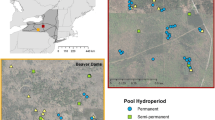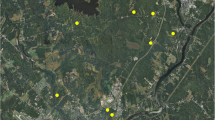Abstract
Assessing the success of created seasonal pools as mitigation for the loss of wooded wetlands is generally based on two or three years of monitoring. We monitored a wetland mitigation site in midcoast Maine, USA, from 1999 to 2004 to track populations of wood frogs (Rana sylvatica) and spotted salamanders (Ambystoma maculatum) in three created seasonal pools. Our goal was to study breeding patterns for six years to assess if presence of breeding animals in the first three years corresponded with long-term reproductive success and to track changes in vegetation development and hydrology in the mitigated pools. Breeding effort (egg masses/female) and reproductive success (juveniles/egg mass) were assessed using full enclosure drift fence/pitfall trap arrays and egg mass counts. Breeding effort was similar in all three pools for both species. However, for wood frogs, reproductive success was inversely related to hydroperiod and highest in the single pool that successfully replicated the desired seasonal water regime. The other two pools developed permanent and semi-permanent hydroperiods, thereby supporting populations of green frogs (Rana clamitans). Green frog tadpoles within these pools preyed upon wood frog eggs and embryos, causing almost complete losses in the last four years of the study. While spotted salamander reproductive success was also reduced in the permanent pool, spotted salamanders were more successful at producing metamorphs in the presence of green frogs. Over the study period, common cattail (Typha latifolia) dominated the pools, and although wetland vegetation did develop, it was not typical of forested seasonal pools. Our work shows that the presence of breeding amphibians characteristic of seasonal pools in the first three years is not sufficient to determine reproductive success of target species in created pools. Hydrology and canopy cover are elements of critical concern if created pools are to support native amphibian communities associated with seasonal pools.
Similar content being viewed by others
Literature Cited
Baldwin, R. F., A. J. K. Calhoun, and P. G. deMaynadier. In press. The significance of hydroperiod and stand maturity for pool-breeding amphibians in forested landscapes. Canadian Journal of Zoology.
Baldwin, R. F. and A. J. K. Calhoun. 2002. Differential predation on ambystomatid egg masses by Rana sylvatica. Herpetological Review 33: 44–45.
Berven, K. A. 1990. Factors affecting population fluctuations in larval and adult stages of the wood frog (Rana sylvatica). Ecology 71: 1599–1608.
Breaux, A. and F. Serefiddin. 1999. Validity of performance criteria and a tentative model for regulatory use in compensatory wetland mitigation permitting. Environmental Management 24: 327–336.
Brodman, R. 1995. Annual variation in breeding success of two syntopic species of Ambystoma salamander. Journal of Herpetology 29: 111–113.
Crouch, W. B. and P. W. C. Paton. 2000. Using egg-mass counts to monitor wood frog populations. Wildlife Society Bulletin 28: 895–901.
Cutko, A. 1997. A Botanical and Natural Community Assessment of Selected Vernal Pools in Maine. Maine Natural Areas Program, Department of Conservation, Augusta, ME, USA.
Denver, R. J., N. Mirhadi, and M. Phillips. 1998. Adaptive plasticity in amphibian metamorphosis: response of Scaphiopus hammondii tadpoles to habitat desiccation. Ecology 79: 1859–1872.
Dietsch, M. B., H. G. Hanlin, E. D. Jones, and L. D. Wike. 1996. Dynamics of a herpetofaunal community in a restored freshwater wetland. Bulletin of the Ecological Society of America 77: 113.
Galatowitsch, S. M. and A. G. van der Valk. 1996. Characteristics of recently restored wetlands in the prairie pothole region. Wetlands 16: 75–83.
Gibbons, J. W. and R. D. Semlitsch. 1981. Terrestrial drift fences with pitfall traps: an effective technique for quantitative sampling of animal populations. Brimleyana 7: 1–16.
Harris, R. N. 1980. The consequences of within-year timing of breeding in Ambystoma maculatum. Copeia 1980: 719–722.
Herreid II C. F. and S. Kinney. 1966. Survival of Alaskan woodfrog (Rana sylvatica) larvae. Ecology 47: 1039–1041.
Ireland, P. H. 1989. Larval survivorship in two populations of Ambystoma maculatum. Journal of Herpetology 23: 209–215.
Kolozsvary, M. B. 2003. Hydroperiod of wetlands and reproduction in wood frogs (Rana sylvatica) and spotted salamanders (Ambystoma maculatum). Ph.D. Dissertation. University of Maine, Orono, ME, USA.
Lehtinen, R. M. and S. M. Galatowitsch. 2001. Colonization of restored wetlands by amphibians in Minnesota. American Midland Naturalist 145: 388–396.
Lichko, L. E. and A. J. K. Calhoun. 2003. An assessment of vernal pool creation attempts in New England: a review of project documentation from 1991–2000. Environmental Management 32: 141–151.
Mierzwa, K. S. 2000. Wetland mitigation and amphibians: preliminary observations at a southwestern Illinois bottomland hardwood forest restoration site. Journal of the Iowa Academy of Science 107: 191–194.
Mitsch, W. J. and R. F. Wilson. 1996. Improving the success of wetland creation and restoration with know-how, time, and self-design. Ecological Applications 6: 77–83.
National Research Council. 2001. Compensating for Wetland Losses under the Clean Water Act. National Academy Press, Washington, DC, USA.
Normandeau Associates Inc. 1995. Sears Island dry cargo terminal: baseline wildlife and wetland studies: final report. Normandeau Associates, Inc., Nashua, NH, USA.
Pechmann, J. H. K., R. A. Estes, D. E. Scott, and J. W. Gibbons. 2001. Amphibian colonization and use of ponds created for trial mitigation of wetland loss. Wetlands 21: 93–111.
Perkins, D. W. and M. L. Hunter, Jr. 2002. Effects of placing sticks in pitfall traps on amphibian and small mammal capture rates. Herpetological Review 33: 282–284.
Petranka, J. W. 1998. Salamanders of the United States and Canada. Smithsonian Institution Press, Washington, DC, USA.
Petranka, J. W. and C. A. Kennedy. 1999. Pond tadpoles with generalized morphology: is it time to reconsider their functional roles in aquatic communities? Oecologia 120: 621–631.
Petranka, J. W., C. A. Kennedy, and S. S. Murray. 2003a. Response of amphibians to restoration of a southern Appalachian wetland: Perturbations confound post-restoration assessment. Wetlands 23: 278–290.
Petranka, J. W., C. A. Kennedy, and S. S. Murray. 2003b. Response of amphibians to restoration of a southern Appalachian wetland: A long-term analysis of community dynamics. Wetlands 23: 1030–1042.
Quinn, G. and M. Keough. 2002. Experimental Design and Data Analysis for Biologists. Cambridge University Press, New York, NY, USA.
Race, M. S. and M. S. Fonseca. 1996. Fixing compensatory mitigation: what will it take? Ecological Applications 6: 94–101.
Reinartz, J. A. and E. L. Warne. 1993. Development of vegetation in small created wetlands in southeastern Wisconsin. Wetlands 13: 153–164.
Rowe, C. L. and W. A. Dunson. 1995. Impacts of hydroperiod on growth and survival of larval amphibians in temporary ponds of central Pennsylvania, USA. Oecologia 102: 397–403.
Rowe, C. L., W. J. Sadinski, and W. A. Dunson. 1994. Predation on larval and embryonic amphibians by acid-tolerant caddisfly larvae (Ptilostomis postica). Journal of Herpetology 28: 357–364.
Seigel, R. A. 1983. Natural survival of eggs and tadpoles of the wood frog, Rana sylvatica. Copeia 1983: 1096–1098.
Sexton, O. J., J. Bizer, D. C. Gayou, P. Freiling, and M. Moutseous. 1986. Field studies of breeding spotted salamanders, Ambystoma maculatum, in eastern Missouri, USA. Milwaukee Public Museum Contributions in Biology and Geology no. 67:1–19.
Shoop, C. R. 1974. Yearly variation in larval survival of Ambystoma maculatum. Ecology 55: 440–444.
Skelly, D. K., L. K. Freidenburg, and J. M. Kiesecker. 2002. Forest canopy and the performance of larval amphibians. Ecology 83: 983–992.
Skelly, D. K., E. E. Werner, and S. A. Cortwright. 1999. Longterm distributional dynamics of a Michigan amphibian assemblage. Ecology 80: 2326–2337.
Snodgrass, J. W., M. J. Komoroski, A. L. Bryan Jr, and J. Burger. 2000. Relationships among isolated wetland size, hydroperiod, and amphibian species richness: implications for wetland regulations. Conservation Biology 14: 414–419.
Stangel, P. W. 1988. Premetamorphic survival of the salamander Ambystoma maculatum, in eastern Massachusetts. Journal of Herpetology 22: 345–347.
Stenhouse, S. L. 1987. Embryo mortality and recruitment of juveniles of Ambystoma maculatum and Ambystoma opacum in North Carolina. Herpetologica 43: 496–501.
SYSTAT. 2004. Systat for Windows, version 11. Systat Software, Inc., Richmond, CA, USA.
Vasconcelos, D. 2003. Amphibian and vegetation dynamics in a restored wetland in Maine. M.S. Thesis. University of Maine, Orono, ME, USA.
Vasconcelos, D. and A. J. K. Calhoun. 2004. Movement patterns of adult and juvenile wood frogs (Rana sylvatica) and spotted salamanders (Ambystoma maculatum) in three restored vernal pools. Journal of Herpetology 38: 551–561.
Ward, D. and O. J. Sexton. 1981. Anti-predator role of salamander egg membranes. Copeia 1981: 724–726.
Whitford, W. G. and A. Vinegar. 1966. Homing, survivorship, and overwintering of larvae in spotted salamanders, Ambystoma maculatum. Copeia 1966: 515–519.
Wilbur, H. M. 1972. Competition, predation, and the structure of the Ambystoma-Rana sylvatica community. Ecology 53: 3–21.
Wilbur, H. M. 1976. Density-dependent aspects of metamorphosis in Ambystoma and Rana sylvatica. Ecology 57: 1289–1296.
Wilbur, H. M. and J. P. Collins. 1973. Ecological aspects of amphibian metamorphosis. Science 182: 1305–1314.
Zedler, J. B. and J. C. Callaway. 1999. Tracking wetland restoration: do mitigation sites follow desired trajectories? Restoration Ecology 7: 69–73.
Author information
Authors and Affiliations
Corresponding author
Rights and permissions
About this article
Cite this article
Vasconcelos, D., Calhoun, A.J.K. Monitoring created seasonal pools for functional success: A six-year case study of amphibian responses, Sears Island, Maine, USA. Wetlands 26, 992–1003 (2006). https://doi.org/10.1672/0277-5212(2006)26[992:MCSPFF]2.0.CO;2
Received:
Revised:
Accepted:
Issue Date:
DOI: https://doi.org/10.1672/0277-5212(2006)26[992:MCSPFF]2.0.CO;2




